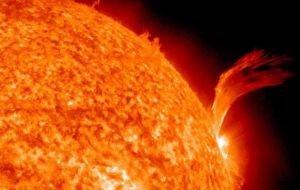MercoPress. South Atlantic News Agency
Biggest solar storm in 7 years could disrupt satellite and electric ground communications
 The spectacular solar flare erupted on Sunday night, and with it, a coronal mass ejection
The spectacular solar flare erupted on Sunday night, and with it, a coronal mass ejection The biggest solar storm in seven years to hit the Earth will begin Tuesday early morning, according to the US National Oceanic and Atmospheric Administration’s (NOAA) Space Weather Prediction Centre. It will likely cause the largest solar radiation storm that the earth has encountered since 2005.
The sun is constantly releasing charged particles into space in the form of an ongoing solar wind, but sometimes, parts of the sun can behave more energetically than others, accelerating particles into space in huge solar flares. This is what happened when a solar flare erupted on Sunday night, and with it, a coronal mass ejection, or CME.
“Coronal mass ejection is the name given to a blob of the sun’s atmosphere that lifts off with the explosion and goes speeding out into interplanetary space,” Terry Onsager, a NOAA physicist, says.
According to Onsanger, this particular CME started travelling towards Earth at about 2000 km/s, or approximately 4.5 million miles per hour, but probably was slowed down slightly. NOAA has a scale for geomagnetic storms that ranges from 1, the most minor, to 5, the most serious. The one that will hit on Tuesday is expected to a 2 or 3.
“When the Coronal Mass Ejection hits us, it’s like a battering ram” Onsanger says. The wave of charged particles is expected to start a geomagnetic storm, screwing up the earth’s magnetic field for a few hours and potentially affecting technologies like GPS and the electric grid that rely on our magnetic field keeping a nice, steady profile. Luckily, this CME is expected to be more of glancing blow to the northern hemisphere than a direct hit.
But even a moderate solar storm has the potential to mess things up here on earth, at least for humans. “It’s not because the sun is doing anything different than it did 100 years ago but because our technological infrastructure has evolved to where it has become more vulnerable to space weather,” Onsanger says.
Our delicate electrical grid is vulnerable to changes in the magnetic field. Unexpected variations can cause surges in the grid, potentially overloading the infrastructure.
Onsanger says that charged protons travelling with the cloud also have the potential to mess with satellites. The protons are small enough to affect sensitive computer chips embedded in the satellites, and could parts of the programming. While satellites today are built with plenty of security measures to ensure that a single solar storm doesn’t mess everything up, a serious solar storm could still wreak plenty of havoc.
A CME like this one can even reroute airline travel. Since the fall of the Soviet Union, airlines have increasingly begun to take the polar route from Europe and North America to Asia, and back. During a solar storm however, protons ionize the atmosphere in high latitudes, causing high frequency radio communications to be absorbed and lost. This matters Onsanger explains, because above 82 degrees latitude, airline pilots can’t communicate using satellites, and usually rely on those high frequency airline channels.
“Many airlines reroute their flights and they will not fly polar routes during that time” Onsanger says. If the storm is bad, airlines will have to deal with crowded airspace and longer flights in the lower latitudes while their polar shortcut is cut off.
Every 11 years, the sun’s magnetic field shifts, flipping from north to south. It flips back again 11 years later. The part of this sequence in which the sun becomes the most active is called the solar maximum. “We are in the ramp up to the next solar maximum,” Onsanger says.
“In the past five or six years there has been an unusual absence of these proton events” Onsanger says. Soon though, there will be more. Scientists expect there to be about four extreme, 100 severe, and around 200 strong geomagnetic storms per 11-year cycle.




Top Comments
Disclaimer & comment rulesCommenting for this story is now closed.
If you have a Facebook account, become a fan and comment on our Facebook Page!